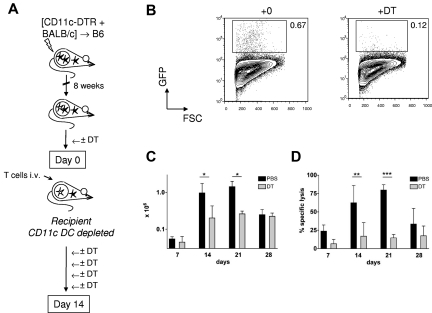Figure 1.
Host CD11chighcells are required for induction of graft-versus-host reactivity after delayed T-cell transfer to allogeneic chimeras. (A) Lethally irradiated B6 mice were reconstituted with a mix of CD11c.DTR/GFP and BALB/c BM, 8 weeks before infusion of 3 × 107 BALB/c Thy1.1+ splenocytes. DT or PBS was given intraperitoneally to recipient mice on day −2 and days 1, 4, 7, and 10 after splenocyte transfer. (B) Contour plots showing GFP reporter expression (specific for host CD11chigh DCs) in dermal suspensions of CD11c.DTR/GFP mice treated with DT or control 24 hours previously (mean percentages ± SD of GFP-expressing cells among live cells were 0.72 ± 0.35 in PBS-treated mice vs 0.08 ± 0.05 in DT-treated mice (n = 4-6 mice per group); data pooled from 4 independent experiments. P < .01. In the spleen of MCs at day 7, mean percentages ± SD of host CD11chighGFP+ among live splenocytes were 0.09 ± 0.04 versus 0.01 ± 0.01 (n = 3 or 4 mice per group); data pooled from 2 independent experiments. P < .05. (C) Absolute numbers (mean ± SD) of Thy1.1+ CD8 cells in recipient spleen of [CD11c.DTR/GFP +BALB/c] → B6 MCs treated with (gray bars) or without (black bars) DT. (D) Specific cytotoxicity in vivo (mean ± SD) directed against B6 strain B cells in the same experiment shown in panel C. (C-D) Data are pooled from 2 or 3 independent experiments (day 7, n = 2 or 3 mice per group; day 14, n = 6 or 7 mice per group; day 21, n = 3 mice per group; day 28, n = 3 mice per group). *P < .05. **P < .01. ***P < .001.

